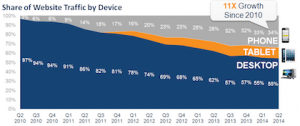By Jessica Langdorf
It is no secret that when it comes to mobile commerce, the usability of the design and features for potential customers who are using a brand's site is a critical factor. This is also true for the live assistance and other forms of mobile engagement that guide and influence these customers.
So what human-computer interaction elements are vital to a brand's mobile experience success?
Mobile growth trajectory peaking
We are entering a new era of mobile.
Although smartphone penetration has grown considerably over the past five years, the mix of smartphone traffic is now leveling off.
The graph below shows a typical example from our customer data – the smartphone mix of traffic grew tremendously by more than 10x from 2010 to 2014, while the mix only increased 16 percent from 2014 to 2015.
This trend is supported by other research as well.
EMarketer has also shown that while mobile sales continue to grow, they are growing at a more shallow growth trajectory than what we have experienced in the past few years.
Now, what is also interesting is that while smartphone and tablet visits are continuing to gain volume quarter over quarter, albeit at a slower pace, desktop visits are remaining relatively flat. This means that mobile traffic is additive rather than cannibalizing desktop and laptop traffic.
 TouchCommerce enterprise customer data: Web site traffic by device
TouchCommerce enterprise customer data: Web site traffic by device
New audience means new approach to engagement
Mobile introduces new eyeballs that brands were previously not taking advantage of, but they are different eyeballs with different intent and in different stages of the purchase-consideration process.
This means that tackling mobile design, engagement and optimization will be increasingly less effective if done in a siloed environment.
In our customer data, the contribution to mobile devices tends to be half that of standard desktop and laptop devices. This is due to deprioritizing mobile engagements as a result of lower conversion rates and lower overall mobile device engagement rates from users. But why?
Lower engagement rates on mobile devices are related to mobile device usability and the user’s level of intent.
Mobile device users tend to be more passive in the engagement as they are less intended browsers – a critical factor to consider in designing tools and campaigns for mobile commerce.
Considerations for boosting mcommerce
So what are the key underlying factors for why mobile devices convert traffic at lower rates than desktop and laptop?
Commonly noted issues include network speed, smaller real estate and limited tactile engagement options: no mouse or traditional keyboard, instead tap, swipe and now gesture.
Furthermore, mobile devices tend to bring in a less captive audience: simultaneous screen viewing, shorter attention spans and less intentional browsing.
But it would be a huge mistake to interpret these lower conversion rates as a bad thing.
It is important to value the incremental nature of new eyeballs to your brand and the corresponding influence that mobile has on retail, phone and desktop purchases.
Here are four areas where improvement can mean huge gains in mobile commerce effectiveness:
1. Mobile funnel design
One big mistake that brands make is to use the same funnel and design that they are using for desktop on their mobile devices.
To get this right, it is vital to implement a mobile-first strategy using mobile engagement design best practice along with conducting tons of A/B and multivariate testing of elements.
2. User behavior differences across devices
The customer experience is not static on mobile devices.
For example, when it comes to screen orientation, most users do not have much of a choice when using desktops and laptops.
But by virtue of mobile devices being held in users’ hands, they are able to customize their experience to their liking.
In our data analyses, we have found that the vast majority of smartphone users rotate their phone to landscape mode when completing an order. This is believed to be due to wanting to use both fingers on the keyboard to enter data into the checkout fields, and because many mobile checkout fields were designed like the desktop – better suited for landscape view.
When designing the mobile commerce experience, ensure that you are not requiring the user to perform unintuitive actions, such as rotating the screen when placing an order.
3. Impactful mobile engagement
Real-time engagement such as live chat can be highly impactful in the mobile environment, but there are many nuances to consider, ranging from chat button placement to window size to timing.
What is particularly important, though, is not to disturb the flow for the end-user.
For example, our A/B testing has shown that a dynamic callout promoting click-to-chat doubled click rates and correspondingly increased mobile chat sales by 80 percent.
A callout is much less intrusive than proactively presenting a chat window on the limited smartphone screen space, and therefore supports the idea of subtlety engagement in mobile-friendly design and targeting.
Another non-intrusive method in engaging mobile users is through automated solutions such as product guides.
In prior testing, we have seen as much as 5 times interest in engagement through automated guides than live assistance.
4. Cross-device tracking
As consumers use more tools when making purchases or buying decisions, it is critical to implement a cross-device tracking strategy that quantifies the significant impact that mobile has on brand sales above and beyond the conversions that occur on the mobile device.
Understanding the differences between mobile and desktop conversion can help brands better interpret conversion rates, while also factoring in the pros and cons of requiring user verification, single sign-on and social media logins in the context of mobile conversion.
ADVANCEMENTS IN usability in mobile designs along with increased user adoption has boosted confidence of transacting on mobile devices.
However, there is still tremendous room for improvement for mobile conversion rates.
By examining specific tips and techniques to capture consumers on mobile and by developing a cross-device tracking strategy, brands can better optimize mobile opportunities.
With the changing dynamics in recent mobile growth, brands will want to make sure that they are squeezing the most results out of the mix.
Jessica Langdorf is vice president of the digital interactions lab at TouchCommerce, Agoura Hills, CA. Reach her at [email protected].
{"ct":"7Vww3ShBAngbV2wpOSDPDIQPi4epkLSLncpYUURAXxn5kx6BqDIBWhF5fuaHs3nDxbjGCGPPDfpoxF\/g\/YgJqP9\/J3RaBn+K7BVzweTUVrrf2mZ813JUUQHaUC9Dpf+zKcnbNtTAzWI6AyJAvIGc6mBoRlGq8IwwrRWPkfph\/WmqQf37BP\/UaGmy6V1hT0rN\/m0V7lY3ZQKbZL73ovYJ4MoEc4wXbyfZ41r\/C4IYUz110BlqVREF2HFtrkdkAGnRiHd1\/DtUoKVlXAm3eYSr33t49d0rlFTrT5ryLv3tuAHmGxeN\/82jOMuZC5P3ll5dzxgs3wygnA8h9H4KTSUnEjKAonvaxMmb+KksSS9E2Aaaa3nIlv17crWAwNBRmNmnMuCWbxQeS3v0OvWRXbvDnLxjBsa3oQoj9iNh3z\/q7IcnbrobON2cd1s0emCZnm5MHbOY48HW7qDdpoXH58lSw6A9wSYCs2hFXCW+H3DiXLTDPJ1ip\/8HAQLS1ZjiXsPOYgRpBE5zGt1M+zPGzW16dAHJRXIbcIiQozSTTmBVX\/2xAGJkCZ5S6FMBNn7jIscReOcArR67T2jq1b4eSzM7eycUOBl916MYQ3hicE2OEmRPl4Z9iO0XEqyMv8QuwwrzmH0kb5vVCnqFl0Js7r7djSUyiMc+pYbKTRJarnSB+Pv0GIGVATP8j0jtIJqiHr+Uma8QNyvRAWET6eKB2fAzqfL0xH9klaqiYM1\/0f5ZKakM5hhWSyEL1eAXpTZCN3lcfvRSyoBA5Ro6OSWw1l6eVzXquVlTKKmCmkfk9aZUCG+UTXZ\/9xucJ7Cxl50Fi0Nky94gIbeVFPUpSkpIdP1rZS8vIkM\/CfyGp1J5trKQlo4UPgQt0\/ZxvfAiWfgp3PoZZT8ttL8YtQyq5UDei3gik9IDvjNoK1S4Wbww86kBYUASfYyXU3YCRSq34WV+qnv6HOpipi2Tk\/L+TLYaaa9DVoUQ7b3FMqR4hBeHCySDo1BY9ZzEpD1Gvk\/NOlahxXbgPvJjvpH1hUNN7er7PEba4DpbjHZc3bAPMQAWBpapGAkvkUNpabNyt736vGZoHM10xJXEN5A\/7oZwDQm4Yp0Q5PbsUbgvJlrow9qjxU+mBJyb3DSmiQRZJQ9Jm2FAKz4isj9WCq8gCwtUlW4nipbV2yJNwVDZdSKxQG\/DYEIlaLWoyfvWAEr+U949nnHJH1TxS5hWIc3VsAW+yeWtJcDjFHSMSa984ifPrtGDBG6JGzm9lHVDAq7gwtSC0nUC\/OOXOkEhYFGkCyu8lO3fvQijrfsqdVgLWb7ubZsC9CJdibwVWRoKW4Ei9ti\/5V8Zns53lMmY7LCayKXKkzQwJk40xCBgRQ0itR97YbvRUvZTxf0FexEfyy5vWg3XltSfa\/IoF3f6xqqzDNtsVIrQbU3j0cB1C\/YOYEhBA1TesnswnbCZXpcqphun5CLB2FmBPexzCYN30s8qry\/O+e7iKj6tvUUCBK5ghY9NtY1NW7Ud7j8pv1hnR6sSC6xiSDG2r5WsaZ\/DLeLyDCOZCBoqF0k93dghaMkbo2sz0yDYx81yNraPW3mT93qDYxTJJs0EMQ5V3SCCo1Cwh1psQx4ccOxolpgiBPW1O5RpfsyJ3SFAkJPFndedl\/q4M9pN1d4upoGz8hgLTN9N27ydyF7p52gEV\/KivpTZ1VzDlSYGI5KWw3bubLcngyY0WGI3AHel1REDhCpQ34gdAChZApm5nf2up+OZfMrTekXVAPjeEhQkqTeorf+Mtc\/mz77klE2B7fC5NEeHtuDop4CyQH+\/BnbVD2BmxP71NN48Z4SBpyYxtEMm+wf0oTHnVXWL\/J3f+c9oGVN94cnDFwC\/Nfu8Su\/vU2qHV40P2i6kO7R3TCsYKNY\/B4mLoZ5WCVjMHTXEciOwHlyOKoLNjteqwrs9LIW7NYcHkEi3yYb+wEx876ILRp3ikkrpkG8tsTBjRttAXzsQSrGrOHNf1ppv+ERVPJ\/jCPvz9+2WJ0uw73nkvesqelotcvp8bC+ji7A0LOL9lnNgWXw\/2ifN1NcskB\/H1kmuXJC7iGmtqYim9HEChDdwA1EjyVvbB6DSxK729AwoLnZxKLFAMNmff1HofV9sbL1n9rOO4RrJmX3eaJB1wub3UU\/53Pl2BnWRtpfP2IodWfNQucuO\/ZC1BNfDwpYCXeJKAvbevvM6ObH6yd53ugG\/PZCEbXXDlpCAYat2LW+65cvIhcEh6Ff8CtYkmb0NhvbguYIfYDoK1x\/gKfbd5n7qordeOr06dEJQCNfabZgw9a1VvCn7XAlLlHilAatYayHmetBwZCf39LTjVMBs+I1cwk8xnkosOf\/a6e+GtsoLNqoiKQLSVF2RPDxYegBCuYNQR+z6uA3h1Ay6nZ1IH\/UXKYmL8XJE1KqV5ZiDoRGnbomiFMpt+MOsF4vBz40ePgDWfeKDXHKowofEGmokaC90IHXRCJA5eajNRn9xgyoX3JsKO4UzWPhKGpwGiLvJkZGErD+c53mMXfvvn+IqpcCoY73gmhcXWhtRLkzh2wEDUrCpZh8P6e1BRMrKgmDrUv8grKrdoUiyUK9fSWO2ehtkmvJ9T6YMTj5ebE0YLvCyxNDsplYGH8P6jZvE3TbhOilCyVaMHsmLUTVUP2odW1ezW6yP3wsNGee05qc1ew1cVLa8ZiYpNG11du6WJrJcFiYv12PVtgPIu+RxaTcrCubp\/izyI3I7le8Xfqu+ed2mamG7xZPJ\/Na22M+ctdITEYYnd8RlZfkQO0Aj0w2Tj8LepJpaygp0AkQArzlfuSKAhwZo1FlQuLYQScNpGmI2Ekc2NkGEx0KLvVFxHegwluUxrygghASEBnl3L1tpDninSYQZ4YOJT7HB2seuMtdCxdjByQyaPFy\/X2HyEfjPOvVRFW+\/GKidJGi78aEkqDg18VNka\/xG0lOOGR\/agtQsbcK85knQ05Y8ckmg01W3OQQeZ82OqMiVu8CfDPOsm2ukg9fddT\/LD0VadnolPHygUMM2KAueaJtcHfQ85O7vkUoBmxrwHHcGfOQYNYqws9+pX7ITWEKcVJBIEBSov8ZuHAAMlOPPKJcCOtR82yJeQAqPsteSdadDyWrv2Y+jqGOT+lP4zta\/RPiFZbGXaQMVoL96HhrK+BGzBWaNyYQwrvIk9e5lHh3+QuSzhTpkSwNz4tJxTBybfzZWUfs6+Atn3a8ikadhSVZLKHgSGep3a\/cbunXeJyAjR18SGGEn3JJsvruOmyOChwf+Mjyy8G4MEn67+oReaJ749lXDtCDkcq+nPbVIgXIQJJAAt5\/NM4gz9QJWWgmEk9Os+vNw1bX7okc0GiPBA8dQJnppKZF3WXpZdtHWMCJbtmjfQAQL9XtNJ1dK3ej9r0aoPUCVdAk49TOZE5gYFvmamAM80YZoUc+taipVPbUniHboT5AYREp53RqDf6HDy+CvrFrw0KuPNFK1BG021jzfW6Thjl+py\/NIfwpbLD1F2b0QSJCrrt\/NnO0J0KldCNjQyRjjYWJnILR15gTjlas5xLMeptCvlfNEQpDt2TbUf+gE9xhyHlFlIy2MH0Ti3enSwmZDDFVPPE8W4o6vddIVD\/o73PSRAWJtnQj3afcBgx8aOq5dpEF2OIrdjvbhJmZAo0Szh++M4VJgq9RqsN+Sd6ZW8fXy+keGRauWTAztBx3NLVpTpFfUg\/KOoZMsHkcWpfiY9\/VYa4iyfstEUq9IRnpvPsfgF\/dh1LFzTQZtZjOTQNt9tVJFwQR4t1TZM1HuKFVTNz1hqys4tsFUEI3HnqEmsZ2eE07haUF53Bjgf+jYq0UkxcbxxYwxT5+qCfb44QZ+G0Ldte1sFjCfNh7eQKN6uXLFLju6lwq\/WI1V06Wt0VgZqMH36tDpt7RnN0mes8p7Q6LVkcZ\/J1zrPHbvogyEuok6xvTbY\/QMPbNPUQ3zvCGguBTTkNJ+rejo+CN4LR6KGi9TagAwVVzW5A8Tp+vYoXY3wg35WDUCQWHrMb59PXCINT5wUPM7f9eAGOApxrSvlUzLQGevmbMVb4js7IDySyDGgJ1O94VRHvXD3i0e6Qg1\/4AG4YlJzEvAZQQowq9y8HFtH4OIBwnHxWhQP1knNq\/XGPZ9EnElVCLyXfa+zJZqoPFG+De2b2Bidl+BZ2YwKz8Jrd\/+wqAzAClGipF+kzjzAW6tM5G58oDAOe5gr\/QmOawGvXv0udoVg9MccnVk+LGz2M0j86AEKSfYp+X46GZgoFaQBFR4xjCvdtt5pBApc\/ZbrNv78KA8Eyr6cLn5aT6u7Ru\/bQmagsQpFIVSyUlowyy0LLgNTWa84OVQQ+IkdYcnMxVp8Ij+8EXhzdIiWaf5ENOgy9fIZhNLUX9BMJ+qg9H1FR4qIOdLghH0x7ptVt8R07dl\/DjfQkOkORLm6YslYVPb5kQTXgrm4F2LHe9Ibk\/yJOfHbLvvbfIw8EZLSf0c7BpQTxObRlnIcYZzppsYOXUiWXZb2iY\/6159eCSXsCyDc+1ouxTU9uGatKqoBrVEKNuB95YC4YeT1yNyb1d87jtrLz7e1yriPfYUqlVbUiPBxFi3NqvpK6+Is+0\/QUl0hQLlzLaDaaXeujPEP2Dgb8Lb2NWGloB9x0FApL5X7bKG8fnLfMjdGoVz4sjuJB7PtiTqfaie+dUeRdLKa+jFxm9ig0F3rywfEv+INgDntZTFS1SPeI\/sJdnOBPGiB8PPf2bLIvF9TBpl0+8JOpgzNuGYBWHuJCD7j+5+8j1KEd7XiUOXmfI2zQ5O5EbX4dJHKCeC+JQKnvQqzvC1RDaJTtXHqjfVWBMNJK9kAvTtekLsDrf4xFoY6IOFyUdOSHVSzkiayqMCgEYOWm1M6AdPtfkZXq7yC\/pzt80sqNTpnmktR1v9coaGzbpMeDqS9xtTcZFbUtfCH0HDROvdLgp4jPkHYluN2jASo2fOcm83TpZ5Y847mPfjkIw85AiqEvCLlfcQ5Dcxw1FmkiMpcHuRYAnY5U3+ToqfJdjk5lwd5rHEQbgllu\/5IvOrNIoxZIFVeAb582lCG2EMYne81ptmLl3qNuFNHz2FbN9aej2DBxdDsLO7S4a3dkbOcoKz4\/0cv4KJFYA+bEMIjP+TUZtur3QEz9q3eZtXWkscIE40do7jxT49kag4RZa3Fp\/O2HP8W8EfysCodEtXDncTnx5bj1U2ZLLirid8PiE1aXWEfHBepBo4R2C+0C7OlQLqYD2WAXOkPYpIyiVpqQRKcA3GqJrGJz4UP27vshzHIpLcfsCUKMCf7CLqvx85Ie+IfJpAYEuy8TPws8CZcLPuFg3Jjbx\/jWfspFBOhGgo42mXNhTbJtmM2llX8TaqPGBok\/wHRNT8pbqpwKBh79zo2hbXuwH2M44Np8O+IX0\/FFafVao43wMEhH\/fOl3my5BGlwlG2Hpv2biVZeRyZATz9QnCyMbAddi\/7pI+mI0xBP86jDHwx8cL27pv7Ta6qhGl7c72bNSx64ogzLQaw2+uhRcdmYwHhMbMZY\/zB5Z4hCmPQLZpuin3Sqo82kpjReAv3+Dj56k1Zwyblr+UNTeulExiujn08Dm5aN16V3EXP5OSegef+b\/AaW+dnQkyUbUmNLgpnSUmPcSJj5KxzmCZye2HJdQBs68q3fXZxyclOIIbRkv1ygwwdZ7cRHDGIPCgdKVwNcoCMc0sVPlHI18Y\/poVOCupLQHgxZE664CPulss7hCBxn8wulnEj5yqal6oY7uFqJJjbfTZALtCCfuI7TkM4xYcxmlcHFVMhQIgVxG23PLQIxjJQJQjB\/TPlaLgyLY+Q8\/YAjMwqqpnQxaR97MB1VC0206yFKYKXigo8XJhhLZ8zoeJu0MBqQEcmbZ6+pSdOdWi9fR7wfVAK0ZdRO\/VXXIj7DOQoeOdx4RVEXTpfjNcszJ6pGvoLr6l6v5+qc+1A+1vgScrr8zy6nSlDQ7l0rDD6u5YMz8ILvNROEq09Su1UzfRtLr3EXf1RGzw2TY6ZMrvHsQ0a+parVzchLsylax2YFZMk2EPmr6zhyYXj9w67sE3MXHKDssP9FHIBRCzjT6ECcOgMd6j0mBDHzs\/4RichVh\/7+9rW1NVjLshAbayVNJI7ISJD7YhrYeN8AtLHg\/w11onfHaNrJpBTWcq5saui1LvHn9iyxaAt6XiwbT6DtKqVrsuulwh+aUCPvGRUz5PsMjHGsELZNX4Hjn7LnGPhGO\/RU9QDgNE3ffoh1EvVXpNoFKWGHJuSsSlwFHmzsbrAZff+FDJL57USFCvY6Gd4ffd8GgddTvKHRpaf1hxB6qX5\/5eaEgjWfRBfs62roGSItQEnFsL1C4yjUjA+JINOzBb2t8x6f1ywOPSdRrN27KVIZzKRxqYUglJlAm6MUXGx+aGqwPAm2zjHATdHuKIbTJJWygkppVz\/aZSUKLv8fk2plVPrcXghF2M7LqkTcKq3eaRrOsqEga0yeSgBtc38FReLZukWDRu+yQCcOu4LZNk38dOD\/3vr7evaIawXPYWbG9AavZEs4MImznsl6OF\/MiyDWM0u4kA3e+nD2McdZIm7EYgpqstSZFyKbR+FyDwsORi7BGioU5PJO0WDR5ABnNzI3oKTNTvSj1L7fjdkb2xIwhuCtTOOYqxOcxsM5UN2zjug4O7pBSPQLocbfgrice7t+1bY\/NzNw0iftWLRW93gLwBTRidHHoPmSSCfabv7bn\/q03AjdRkwZP9h43yiPXyZ+QUF7ePVXWKalOU3kl3L38jI+vdm4Q5uQvuQ9cJTu0G1Ic5PjlJHwYxmuHKYF3jW4vuPjmiQoisvftnDOIremje5anqPjBJooLGUlcqLGVPUiuEWY8iUz4VfI\/ciOQ92tkzwIZBoVKrHaWpp6h3fAWJyceqG+z2e+ixrhvU15lDrS3vccSJcqFS7GqBr5Z8l\/UBtAtHCeuQoQX\/\/QTBHfYD39qS6ZGchdwM2vSo4M9t9d9Eu2aPe4WvhLNUiCzV5OGf\/\/SOo9SijI\/s3D2+1rvIXuTQai7Bkvn6EyfOpAJvaF2ltCp2hYascQarLmXpZ+E\/d9F154H2um5VunUdT\/iyJbuRWKyt3EBvVVpnHK7GpIsJxz9oL3IM088yswfRh1+V26dFnzdHyOoLY9wtyK2e6L1wvKswwMXOPEKWRLxex7d5NnmnXydb\/uhZ9XVWCcupUlYS9UVwE0vRF6CevRIVBk+t2kopWAG2ZemdcEAvlyf7wL2HYqKmSsun5qCuuktkeMvpgSayx8F5ALCl0KZiYGeVew3CQzokyY8aBIHJ5BxXsUe8TXIS0P70QCluWVVJoNE0yHDI9lYF3s1in6ajupWuOw6a5MUyi6qilV2SltR5aoqIo7eH8QoVTNKaq67rNNATmb7a3GKX1wIAhbl1x3Fw6h0VCmTnaMnm6i5ziTgQJ76cr4qMJfuZKuuUGzxha8NtUI03lx8g7E+Jz2UUKQSytX5EIXCgjPozndeRzXHgn3rSUabHuNPVMJ6WwBkUBHWSRBU9bL8+jT28vtbHPf6+XUaP6S37bW4hDO9\/ah5qfdg4cCRo8ZEdj8Ru5lgkS5IMhHxl90AOlBaD1xVIsu\/FSu8vxZWaATVcCk2hWA8II5w3zoOigebodNyZOXLBzdLqcKCMRWeqz5sDdVV3t8myx2nUjN0lB4fC1CwuLEeFTyU+hTGjcFqx0r6Gsg6XZl55LedeqU4Mks15rVwLCjiV44fhgJztV9LRuv1QT8coVl2PfYs62XqbyWg7PRQeTxKvVku5Odhjt8gNgwCOlfoA2IJDzWuDqtqUQSvPF4xZlxpEqr0iS\/UP\/wej3Mn5NV4vf7i9u1zh7bPLoQAEKlWB+iDUjFQAf1GtKozTUTqAO0rDdlb1o1xG2n\/DKRFzm6MpIbHz0nEsPBPO6mK23385vXiPebSVs0ajoN2WDyLcRDtwURVyfsbLkikbsp0zvO6mZ2l6p7JlKwB9ogbSoFggUZ69PeJeiBetdYnkKUZoCeQV6U1JfJvuKIwVUH4lawFIKYhiG4rsc4rrhh3Lgfnh5T0brDCae9pxMjM2UXuSxw3tlc7kLKCx9DwNiYKuqZHW944nSbTNGHbKu9tm5impX\/lIrEGkEqv2\/0iIJYp9vQ\/t7c6vho7Uiz\/U6ce32z1ZY9rJjCSrfiimUma9VU6\/SPm7A8FXwzOlL9HWl+Tn9zL6UC6jbdMQ0efy7LeNJkKFJJqlOGmKWhbt8aBYQuuXCkvmJjsZnTTSSuApr4XqA0a2s1kq49WhqYRp87uQPAczoP5sUfK44kgqFDrrG\/BBQqUzz0mgPyzDxcs4z+fCPWrDcRzO\/UqrKll5hH0VFTpRCZz7QcAqf2azrpkiyCbrmWA6nxIdxY9qHfHSjOSyArNnntn80lejAeUaPyr9nmesKnNLYZ67XzpJUn4gDD9xot51RFb3tVNfWiRJp\/0azEyYehep3yIoSb4e6XqPLad6D3W2uIUaf9QmQoHGi3q6hN4cp8HDtvf1yzgVwf8ayo1BOKjLloitz4nnz87WcAFjU6Wki7SlMOQrYUEyE8TBRY0aZ9A0GYXdfH0be8tiOilXcqTBJscWtb5Y34pfIARU7wIkZeD\/8d2A3S6jFreZeewcnMTmSzNjHK8\/+HG2\/XFZ1A3\/hLUWp0KlDqVqG+ZlQZN0R+ER8lTtMb0hqmUSOhUpLHMItL0pcYCD3iVsSM0015yyOAIrr6OdkXXrIWojTKYGv3NhV\/D7KUyivmQ56+cnishyzYuXMMHEWet8EPh3HOP8LKxZ5w7iDkGz51P8exe5VLyUwJSmoGCNvrYGgRZc74BggqWyV\/KrBE7rOL\/T1tmqOaOrdkeEuhQm1bSkjtmkYygrd96y2a7TYYk52e+TRnReKa2bqpJBl8GrskfxQAoWRMMrnAXzJOruvcJRtOnDExvaMlIfa5HbJiRl9Vhr9hGdEPcN+xd3zO5ZlugkOV+x1qSy\/VHZqT3uMOH9oAgDmDueLfRa6ucopoxApy0Gxxzr+ZFwdIDOBaccrbyE8GEUgicPW3+L67lFY8md1r2JtkPo8ynVGJqde9M3JyaGRnH9+fVm\/sRfJqNIbRRl+EXnt8xsQoEoKZV7HwSipszZOdlj5CS7hPLN69usM6S9+XA+OJQpgJoQTEvBjdL8+GSYpNs2YP8W9TSmCS3kmXr4YFxJgvL4vMYaZJFVYr0zGxW7aJosA3v0i4QeTRuu3euBgask8sEMOJSaeuwZWMRuB9pU3DkMXzMiWVBxvNT2mgAd1HevoUKptM59zB1s4QRsFdFDdrYq+y78x9YFOdITavigJ7EAm1Q1kFCHVkufiz+35NqgYGRHwvX5EWhwmeu7vJU8coR\/6Z9+Cm4Tl9b3glsE4IfyTeiv9GGKiS08jSd6KieLQdqu+YDCN7\/NdggW8dc8WdSjlGoh9hFZaQXRLeD0\/wCwuWZMJbAu03oMNV7dtFeMiGBahsA7BWl3VGqH8+eadhvm6PrzTMc6+Qvdnm6j1HKPQniHKCGoR2\/89BHFou\/DRVUNPuhi3fr9x80Mc9m8sNYuBJkOs3b\/gm3L9KdSSFYhLYL3flUZRvF\/BWpo+uYyk\/Os+IvjThegyLED7a8aJj4Qm+C3ct487iwG3YR16CdFsNR2b5vjuyY+Y1TJUrWiMXl36sTt\/InwoF06d0Apj7R771xEUR9nGiHgIPGJdzm9qhKdxLMQR3jsi9lFG6PT6rBVh2BjnJKAbJVzIxyj06WW71qeZLIP4SEkjhh6RpipYj0QxbNwaoUhbpZ3ueETRNu2WU7yTi+Hxzx\/moI6NluVfaXsM2IlZLzj2T5toeCfVWXV+wh2LtmPutKKDdVDbnE6sQ2r7vsl4tecMvB25ceEb66mrhUyvZHMhtiqEY+jdqHMEWWe2tbED2k+QNLbeWWiNokc+Q4ITA1yIwoWKg6rCojHr7q5Vz4wRN3A6vzN0oXomBRKgibUru+mYEiIjFBsmd34RDx7wElyumcGffMG6odB4TowRm02M3XwW4DiQgbtrCXg501lc74+TCCgFpdoYhQ0Z\/FBIKNEpULLDkW+8IhwUDwFU85FFp++d\/17b4apOjsQiYXOIQ4Z8\/Dc1kbo1ABuDddyadGhXd2hUx2ch7lWJFFyUy8gPVbZF\/lqqGAbaCbJeppByR+AvRfjzZi59+iqyzbT2Fz15FXNlnaB3OgONxEYvkqNFX0QEPFctxw+Nn5cSQjDuZfX95TLMKsilQyT7BDpwOLfd13K+V\/FMqKFL5Z1wLD6EX60kdEMgbbZrGkl3LcPnBSCYhrvfFwhVc+onYiMzdCwcs25z7GaQiCzcGY8vh9FqwCLQQ2NhRx9V8iuYH26P9Jb6fqcmRBAbK1xoFRsYzr1NpCmBJp86DhXAPTDlQITdbQ\/6edGvTIvWYosZExIAmiM\/PS2","iv":"50c86f9c8a410c69da75128e30785c0d","s":"3988a4fb2d74d99a"}

 Jessica Langdorf is vice president of the digital interactions lab at TouchCommerce
Jessica Langdorf is vice president of the digital interactions lab at TouchCommerce
 TouchCommerce enterprise customer data: Web site traffic by device
TouchCommerce enterprise customer data: Web site traffic by device